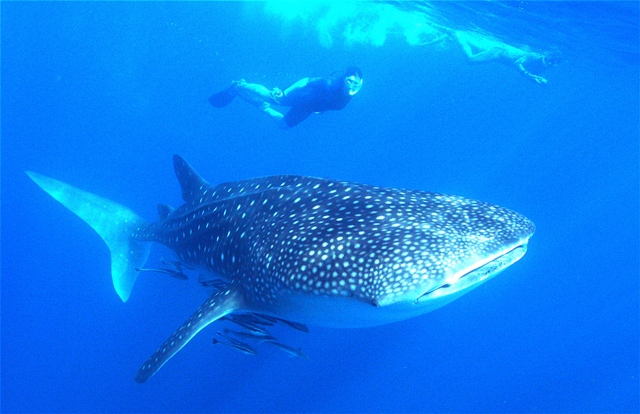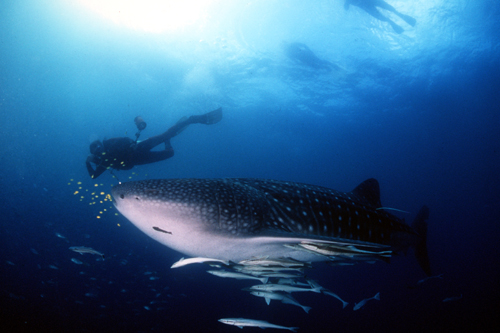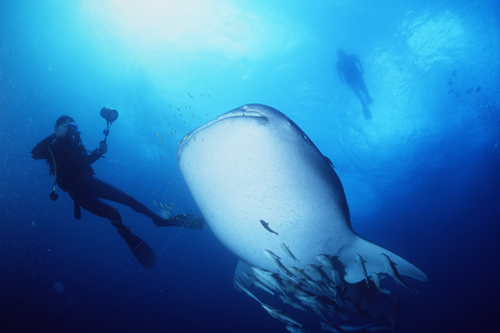Description:
An unmistakeable huge, filter feeding shark. Broad flat head, short snout, huge transverse almost terminal mouth with numerous small scale-like teeth, in front of eyes. Prominent ridges on body the lowest ending in a keel on the caudal peduncle. Lunate unnotched tail fin. Nostrils with rudimentary barbels. Long nasoral grooves. Spiracles close to and larger than eyes. 5 exceptionally large gill openings, the fifth behind the pectoral fin.
Colour. Checkerboard pattern of yellow or white spots on grey, bluish or greenish brown back. Horizontal and vertical stripes on back and sides of body. White or yellowish ventrally.
Size:
Maturity: a minimum of 800cm TL. Max Length: 1700cm TL Male, 2,000cm TL Female. Commonly to 1,000 cm TL.
Habitat and Ecology:
Found in both coastal and oceanic habitats (depth 0 to at least 1,928m but majority of time is spent 0-200m). Oceanic sightings are strongly correlated with temperature with most occurring between 26.5° and 30°C in the Indian Ocean. Highly migratory between ocean basins but returns to the same sites annually. Found singly or in aggregations which can on occasion number over 100 individuals. Often associated with groups of pelagic fishes, especially scombrids. Feed on planktonic and nektonic prey, such as small fishes (sardines, anchovies, mackerel, juvenile tunas and albacore), small crustaceans and squids. Ovoviviparous. Embryos feed solely on yolk. The smallest free-swimming neonate found in the wild, from the Philippines, was 46 cm TL. The single pregnant female that has been physically examined, from Taiwan, had 304 pups in various stages of development, the largest litter size reported from any shark species. The largest size class of embryos, 58–64 cm TL, appeared close to fully developed.
Fishery Status:
Though not previously targeted by the local fishery this species has received full protection under the Wild Animals and Birds Protection Act since 2003. S.I. 1 of 2003 Wild Animals (Whale Shark) protection Regulations (3rd February 2003).
Notes:
Photos courtesy of the marine Conservation Society, Seychelles (MCSS)
The Whale shark has been the subject of extensive study in Seychelles based on the work of Dr David Rowat. Some papers pertaining to this work in Seychelles and regionally are listed below.
Rowat, D. 2007. Indian Ocean whale shark occurrence: a case for regional conservation. Fisheries Research 84: 96-101.
Rowat, D. & M. Gore. 2007. Regional scale horizontal and local scale vertical movements of whale sharks in the Indian Ocean off Seychelles. Fisheries Research 84: 32-40.
Rowat, D. & U. Engelhardt. 2007. Seychelles: A case study of community involvement in the development of whale shark ecotourism and it's socio economic impact. Fisheries Research 84: 109-113.
Rowat, D. et al 2007. New records of neonatal and juvenile whale sharks (Rhincodon typus) from the Indian Ocean. Environmental Biology of Fishes: 82 (3): 215-219.
Rowat, D. et al 2009. Aerial survey as a tool to estimate whale shark abundance trends. Journal of Experimental Marine Biology and Ecology 368: 1-8.
Rowat, D. et al 2009. Population abundance and apparent survival estimates of the Seychelles whale shark aggregation. Oryx 43: 591-598.
Rowat, D. et al 2011. Long-term membership of whale sharks (Rhincodon typus) in coastal aggregations in Seychelles and Djibouti. Marine and Freshwater Research, 62, 621-627.
Rowat D. & Brooks K. S., 2012. A review of the biology, fisheries and conservation of the whale shark Rhincodon typus. Journal of Fish Biology 80: 1019–1056
Andrzejaczek, S. et al (2016). Ecological connectivity of whale shark aggregations across the Indian Ocean – a photo-identification approach. Royal Society Open Science. 2016;3(11):160455. doi:10.1098/rsos.160455.
Brooks K.S. et al 2010. Seeing Spots: Photo-identification as a Regional Tool for Whale Shark Identification. Western Indian Ocean J. Mar. Sci. 9 (2), 185-194.
Capietto, A. et al 2014. Mortality of marine megafauna induced by fisheries: Insights from the whale shark, the world’s largest fish. Biological Conservation 174 , 147–151
References:
Ebert, D.A. et al (2013). Sharks of the World – A fully illustrated guide. Wild Nature press ISBN 978-0-9573946-0-5
Froese, R. and D. Pauly. Eds. 2018. FishBase. https://www.fishbase.de/summary/2081 (31/05/20).
Pierce, S.J. & Norman, B. 2016. Rhincodon typus. The IUCN Red List 2016: e.T19488A2365291. https://dx.doi.org/10.2305/IUCN.UK.2016-1.RLTS.T19488A2365291.en. (31/05/20).
Citation:
Nevill, J.E.G. (2020). Seychelles Seatizens. Rhincodon typus. https://seatizens.sc/species/rhincodon-typus-smith-1828/




There are no comments